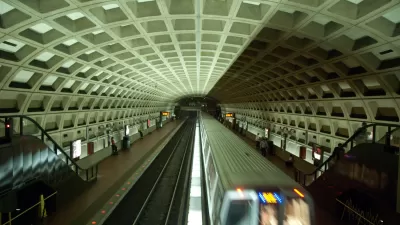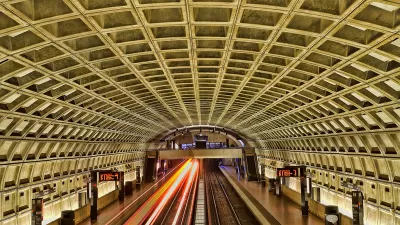Ridership on the region’s rail systems is rebounding faster than other major transit systems.

Transit ridership in the D.C. region is growing faster than in any other part of the country, reports Dan Malouff in Greater Greater Washington, with a 67 percent increase in ridership in the last year.
As Malouff explains, “Riding a 67% ridership increase over the past year, Metro grew faster than any other heavy rail public transportation in the United States during that time. DC Streetcar led all nationwide light rail systems, up 140%. And VRE led all US commuter rail systems, up 114%.”
The regional commuter rail agency, MARC, also saw a 69 percent increase in ridership, but didn’t lead the nation. Similarly, Metrobus ridership was up 41 percent. The figures come from a American Public Transit Association (APTA) ridership report. New York City’s subway system remains, by far, the nation’s most popular, with a ridership of six million in the first quarter of 2023.
Malouff notes that bus systems show less impressive ridership rebound numbers in part because buses lost fewer riders during the pandemic, when the transit-dependent workers who largely rely on buses to get to jobs deemed ‘essential’ continued to use public transit more than white-collar office workers who switched to remote work and who make up a higher proportion of rail riders.
FULL STORY: With soaring Metro, DC Streetcar, and VRE ridership, Washington region leads transit recovery in US

Study: Maui’s Plan to Convert Vacation Rentals to Long-Term Housing Could Cause Nearly $1 Billion Economic Loss
The plan would reduce visitor accommodation by 25,% resulting in 1,900 jobs lost.

North Texas Transit Leaders Tout Benefits of TOD for Growing Region
At a summit focused on transit-oriented development, policymakers discussed how North Texas’ expanded light rail system can serve as a tool for economic growth.

Using Old Oil and Gas Wells for Green Energy Storage
Penn State researchers have found that repurposing abandoned oil and gas wells for geothermal-assisted compressed-air energy storage can boost efficiency, reduce environmental risks, and support clean energy and job transitions.

Private Donations Propel Early Restoration of Palisades Playground
Los Angeles has secured over $1.3 million in private funding to restore the Pacific Palisades playground months ahead of schedule, creating a modern, accessible space that supports community healing after recent wildfires.

From Blight to Benefit: Early Results From California’s Equitable Cleanup Program
The Equitable Community Revitalization Grant (ECRG) program is reshaping brownfield redevelopment by prioritizing projects in low-income and environmental justice communities, emphasizing equity, transparency, and community benefits.

Planting Relief: Tackling Las Vegas Heat One Tree at a Time
Nevada Plants, a Las Vegas-based nonprofit, is combating the city’s extreme urban heat by giving away trees to residents in underserved neighborhoods, promoting shade, sustainability, and community health.
Urban Design for Planners 1: Software Tools
This six-course series explores essential urban design concepts using open source software and equips planners with the tools they need to participate fully in the urban design process.
Planning for Universal Design
Learn the tools for implementing Universal Design in planning regulations.
Ascent Environmental
Borough of Carlisle
Institute for Housing and Urban Development Studies (IHS)
City of Grandview
Harvard GSD Executive Education
Toledo-Lucas County Plan Commissions
Salt Lake City
NYU Wagner Graduate School of Public Service





























